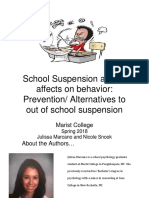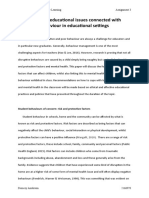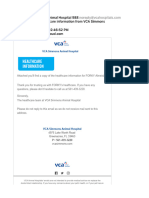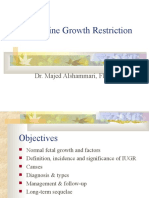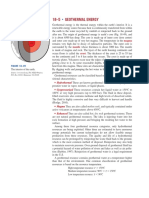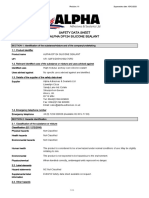Anna's Behavior (Operant)
Anna's Behavior (Operant)
Uploaded by
Daniel GitauCopyright:
Available Formats
Anna's Behavior (Operant)
Anna's Behavior (Operant)
Uploaded by
Daniel GitauOriginal Description:
Copyright
Available Formats
Share this document
Did you find this document useful?
Is this content inappropriate?
Copyright:
Available Formats
Anna's Behavior (Operant)
Anna's Behavior (Operant)
Uploaded by
Daniel GitauCopyright:
Available Formats
Using examples from the case-specific resources (e.g.
, video consultation with intake
worker), identify how Ana's behaviour has been, or is being, influenced by operant
conditioning and social learning theory. In what specific ways are these learning principles
influencing Ana's behaviour? Your answer should be supported with evidence from the
literature.
Ana's conduct has been affected by learning and accordingly has become sensitive and
aggressive. Ana's behavior has been influenced by her surrounding environment as she has
learned most of her behaviors from the people in her immediate surrounding environment.
Social learning
Social learning theory is made up of personal factors, behavioral factors, and environmental
factors. All three factors interact with each other to influence how an individual behaves
(Eriksson et al., 2019).
Classical conditioning
Forming associations among stimuli. Ana reacts to the smell of the rehab center as it is a
reminder of her dad's injury
Operant conditioning
Under this conditioning, learning is a result of the consequences of the individual’s behavior.
• Ana demonstrates desired behavior therefore Kat rewards her with chocolate (Positive
reinforcement)
• Positive punishment is expressed when is yelled at and hit by Kat when she is naughty, but as
soon as she cries and becomes upset she comforts her.
• Negative punishment is expressed when Chris takes away Ana’s doll for her not
acknowledging the social worker.
• Kat smacked Ana when she didn't wear her eye patch (negative punishment) (Bouton &
Balleine, 2019).
Identify two factors from the case-specific resources that may be contributing to Kat's
memory difficulties
The expanded emotional attachment of Ana is a problem for Kat since she can't leave Ana
without causing an aggravation which brings about Kat being behind schedule for work or
incapable to go to desired meetings (Buultjens M. and Buultjens, 2016). This is expressed in the
story that she was late because of Ana not getting inside the vehicle to go to the meeting. Ana's
conduct additionally adds pressure towards Kat. Compelling her to discipline Ana prevent an
escalation of the situation in which the assistant is making a divide between both Chris and Kat
on how they need to teach Ana.
References
Bouton, M. E., & Balleine, B. W. (2019). Prediction and control of operant behavior: What you
see is not all there is. Behavior Analysis: Research and Practice, 19(2), 202–212.
https://doi.org/10.1037/bar0000108
Buultjens, M., & Buultjens, P. (Eds.). (2016). Individual Determinants of Health and Human
Behaviour. La Trobe University Press/Pearson Australia.
Eriksson, M., van Riper, C. J., Leitschuh, B., Bentley Brymer, A., Rawluk, A., Raymond, C. M.,
& Kenter, J. O. (2019). Social learning as a link between the individual and the
collective: evaluating deliberation on social values. Sustainability Science, 14(5), 1323–
1332. https://doi.org/10.1007/s11625-019-00725-5
You might also like
- Hydrogen Peroxide Cancer TreatmentDocument10 pagesHydrogen Peroxide Cancer Treatmenttkocak999100% (1)
- N800 Technical Training - Electircal & Electornic JMCDocument52 pagesN800 Technical Training - Electircal & Electornic JMCRusonegro0% (1)
- ASC 2000 P764331-449 10-07-03 Draft PDFDocument83 pagesASC 2000 P764331-449 10-07-03 Draft PDFSergio MontesNo ratings yet
- Case Study On Child CareDocument8 pagesCase Study On Child CareAnonymous MFh19TBNo ratings yet
- Campbell The Impact of A Schoolwide MindfulnessDocument18 pagesCampbell The Impact of A Schoolwide MindfulnessValentina Denise Dávila SosaNo ratings yet
- Bullying Reflection PaperDocument6 pagesBullying Reflection PaperAndrewSmith33% (3)
- 2022 Article 123Document12 pages2022 Article 123Loes JankenNo ratings yet
- Case StudyDocument15 pagesCase Studydharsanie rampersaudNo ratings yet
- Kalket and Wilson-Milestone 3 Literature ReviewDocument13 pagesKalket and Wilson-Milestone 3 Literature Reviewapi-704711481No ratings yet
- Sun 2019Document11 pagesSun 2019Aprilia SeasariNo ratings yet
- Attachment - and Emotion-Focused Parenting Interventions For Child and Adolescent Externalizing and Internalizing Behaviors A Meta-AnalysisDocument21 pagesAttachment - and Emotion-Focused Parenting Interventions For Child and Adolescent Externalizing and Internalizing Behaviors A Meta-AnalysisbrilliantinexxlNo ratings yet
- 710-Article Text-2654-1-10-20210511Document11 pages710-Article Text-2654-1-10-20210511GLENN BROMBUELANo ratings yet
- Psychology OrderDocument4 pagesPsychology OrderGrace MwangiNo ratings yet
- Guan 2021Document10 pagesGuan 2021lulixbeNo ratings yet
- Physical Contact and Loneliness - Being Touched Reduces Perceptions of Loneliness CritiqueDocument6 pagesPhysical Contact and Loneliness - Being Touched Reduces Perceptions of Loneliness Critiquefrnscnn eNo ratings yet
- Annettes Case Study AdditionDocument15 pagesAnnettes Case Study AdditionAmtul AzizNo ratings yet
- Harsh Disciplinary ActionsDocument3 pagesHarsh Disciplinary ActionsJoana Mae N. BocayaNo ratings yet
- Bolutano and Evangelista Final PaperDocument59 pagesBolutano and Evangelista Final PaperAria IsipNo ratings yet
- Nichols Writing Sample FinalDocument11 pagesNichols Writing Sample Finalapi-543323726No ratings yet
- Bonnie CaseDocument4 pagesBonnie CaseNeha DhoundiyalNo ratings yet
- Self-Efficacy Among Unmarried Black Mothers and Fathers of Young Children: A Pilot StudyDocument8 pagesSelf-Efficacy Among Unmarried Black Mothers and Fathers of Young Children: A Pilot Studyapi-534704135No ratings yet
- The Relationship Between Anxiety and Social Support Among Filipino Tertiary StudentsDocument6 pagesThe Relationship Between Anxiety and Social Support Among Filipino Tertiary StudentsPsychology and Education: A Multidisciplinary JournalNo ratings yet
- Apsy 674 Groupe InterventionplanDocument27 pagesApsy 674 Groupe Interventionplanapi-161848380No ratings yet
- Austin_Boone Benchmark Research Proposal PaperDocument5 pagesAustin_Boone Benchmark Research Proposal PaperbillingNo ratings yet
- JeerapornKummabutr PaperDocument12 pagesJeerapornKummabutr PapermuralinaiduNo ratings yet
- KFP Final PaperDocument18 pagesKFP Final Paperapi-726319946No ratings yet
- Screenshot 2023-05-16 at 11.29.57Document3 pagesScreenshot 2023-05-16 at 11.29.57sashairene2000No ratings yet
- Article Critique - Exp PSychDocument6 pagesArticle Critique - Exp PSychfrnscnn eNo ratings yet
- Mental Health Help-Seeking in Adolescence - An Exploration of VariDocument58 pagesMental Health Help-Seeking in Adolescence - An Exploration of VariAyu Anggreny Layang DongaNo ratings yet
- Article 1Document10 pagesArticle 1ROSANo ratings yet
- Milestone On Childhood Trauma and Its Impact On Adult Interpersonal RelationshipseditedDocument6 pagesMilestone On Childhood Trauma and Its Impact On Adult Interpersonal Relationshipseditedspearheadke1999No ratings yet
- Personality and Individual Differences: Ruodan Wang, Qing Liu, Wenjuan ZhangDocument9 pagesPersonality and Individual Differences: Ruodan Wang, Qing Liu, Wenjuan ZhangAschalew AsnakeNo ratings yet
- Bullying - Its Impacts and Effects On The Grade 11 Students of Csa-BDocument13 pagesBullying - Its Impacts and Effects On The Grade 11 Students of Csa-BAngel Lynn100% (2)
- Iop2604 Assignment 06Document5 pagesIop2604 Assignment 06tthaiva118No ratings yet
- Liam Nathaniel Solis (Thesis)Document31 pagesLiam Nathaniel Solis (Thesis)Liam Nathaniel V. SolisNo ratings yet
- Social Cognitive Theory DocumentDocument19 pagesSocial Cognitive Theory DocumentRushane HyltonNo ratings yet
- Explain RDDocument5 pagesExplain RDTin TinNo ratings yet
- d7 - Intervention Plan Separation Anxiety Apsy674Document34 pagesd7 - Intervention Plan Separation Anxiety Apsy674api-164507144No ratings yet
- Behavioral Family TherapyDocument6 pagesBehavioral Family Therapyiulia9gavrisNo ratings yet
- Impacts On Intrinsic Motivation Through The Use of Behavioral ChartDocument13 pagesImpacts On Intrinsic Motivation Through The Use of Behavioral ChartCarlo MarmolejoNo ratings yet
- EthicsDocument7 pagesEthicsAsia AbduNo ratings yet
- Woodcock 2003Document20 pagesWoodcock 2003adelNo ratings yet
- Selfcare Plan For My Personal Destressing.Document7 pagesSelfcare Plan For My Personal Destressing.Nimian 254No ratings yet
- Social Science & Medicine: Allison Milner, Lauren Krnjacki, Peter Butterworth, Anthony D. LamontagneDocument7 pagesSocial Science & Medicine: Allison Milner, Lauren Krnjacki, Peter Butterworth, Anthony D. LamontagneJohn AcevedoNo ratings yet
- 5710 Unit 5 Writing AssignmentDocument4 pages5710 Unit 5 Writing AssignmentViktoriya ZafirovaNo ratings yet
- Humss 11 A4 Isabelle PDocument22 pagesHumss 11 A4 Isabelle Pisabellepansoy9No ratings yet
- Alternatives To Out of School SuspensionDocument58 pagesAlternatives To Out of School Suspensionapi-202351147No ratings yet
- Orca Share Media1583582082662Document40 pagesOrca Share Media1583582082662AntonetteEspinaNo ratings yet
- DissertationDocument26 pagesDissertationannphuong3009No ratings yet
- Impact of Childhood AbuseDocument6 pagesImpact of Childhood Abusebeatriz.jmacedo11No ratings yet
- Order 2031226 Child Welfare SystemDocument4 pagesOrder 2031226 Child Welfare SystemAntony OmbogoNo ratings yet
- Final Research WorkDocument13 pagesFinal Research Workjaphetmaraga003No ratings yet
- FinalautismDocument9 pagesFinalautismyanwee.heNo ratings yet
- Mental Health Presentation Autism Spectrum Disorder 3Document47 pagesMental Health Presentation Autism Spectrum Disorder 3Lopez ElaineNo ratings yet
- Grade 10Document16 pagesGrade 10Sonia NaickerNo ratings yet
- Abm Homer Group 3 Research Paper 2Document18 pagesAbm Homer Group 3 Research Paper 2Aviona Gail RazoNo ratings yet
- Emotionally Focused Family Therapy and Play Therapy Techniques PDFDocument11 pagesEmotionally Focused Family Therapy and Play Therapy Techniques PDFmanhuertasNo ratings yet
- Evaluating How Online Classes Affects Students Mental HealthDocument4 pagesEvaluating How Online Classes Affects Students Mental HealthCush Vhenz JoseNo ratings yet
- WHO statsDocument11 pagesWHO statsrubab8065No ratings yet
- Key Wider Educational Issues Connected With Behaviour in Educational SettingsDocument10 pagesKey Wider Educational Issues Connected With Behaviour in Educational Settingsapi-500494073No ratings yet
- CBT and Social Skills Training MaterialsDocument4 pagesCBT and Social Skills Training MaterialsNtasin AngelaNo ratings yet
- Menstrual Hygiene Management Among Junior High School Girls A Literature ReviewDocument18 pagesMenstrual Hygiene Management Among Junior High School Girls A Literature ReviewGayathri GNairNo ratings yet
- Education and Science: The Brain’s Body Help to Improve Brain, Body, and Sense EventsFrom EverandEducation and Science: The Brain’s Body Help to Improve Brain, Body, and Sense EventsNo ratings yet
- ApnDocument2 pagesApnDaniel GitauNo ratings yet
- Briefly Summarize The Article and Its Findings. Summary of The ArticleDocument4 pagesBriefly Summarize The Article and Its Findings. Summary of The ArticleDaniel GitauNo ratings yet
- Company Communication - EditedDocument3 pagesCompany Communication - EditedDaniel GitauNo ratings yet
- Children's Communication Skills - EditedDocument3 pagesChildren's Communication Skills - EditedDaniel GitauNo ratings yet
- Continuing Care Assistan (CCA)Document5 pagesContinuing Care Assistan (CCA)Daniel GitauNo ratings yet
- Children Decisive InfluenceDocument1 pageChildren Decisive InfluenceDaniel GitauNo ratings yet
- DiscussionDocument4 pagesDiscussionDaniel GitauNo ratings yet
- Australia HealthcareDocument2 pagesAustralia HealthcareDaniel GitauNo ratings yet
- Coding HealthcareDocument2 pagesCoding HealthcareDaniel GitauNo ratings yet
- Customer Retention Activities Using Data MiningDocument3 pagesCustomer Retention Activities Using Data MiningDaniel GitauNo ratings yet
- Clinical ObjectivesDocument9 pagesClinical ObjectivesDaniel GitauNo ratings yet
- Data-Driven Decision Making - EditedDocument3 pagesData-Driven Decision Making - EditedDaniel GitauNo ratings yet
- Dicease CenterDocument1 pageDicease CenterDaniel GitauNo ratings yet
- Clinical ReasoningDocument3 pagesClinical ReasoningDaniel GitauNo ratings yet
- Cocacola Company - EditedDocument3 pagesCocacola Company - EditedDaniel GitauNo ratings yet
- Revised National Plumbing Code of The Philippines (Principles)Document2 pagesRevised National Plumbing Code of The Philippines (Principles)Vanessa DamasoNo ratings yet
- FORKY's Healthcare Information From VCA Simmons Animal HospitalDocument3 pagesFORKY's Healthcare Information From VCA Simmons Animal HospitalcynthiaxgallNo ratings yet
- DSE9450 DSE9452 DSE9479 Installation InstructionsDocument2 pagesDSE9450 DSE9452 DSE9479 Installation InstructionsHor EdwardNo ratings yet
- Capstone Project Report MBA 702A, 703A, 704A Indian Institute of Technology, KanpurDocument13 pagesCapstone Project Report MBA 702A, 703A, 704A Indian Institute of Technology, KanpurPrakhar DikshitNo ratings yet
- Calculations SheetDocument3 pagesCalculations SheetSami SawalhaNo ratings yet
- Intrauterine Growth Restriction: Dr. Majed Alshammari, FRSCSDocument72 pagesIntrauterine Growth Restriction: Dr. Majed Alshammari, FRSCSapi-3703352No ratings yet
- Steel Solutions For International NuclearDocument9 pagesSteel Solutions For International NuclearSandeep GargNo ratings yet
- Investigation 6b eDocument12 pagesInvestigation 6b eMBOTAKE LawsonNo ratings yet
- Ch18 GeothermalDocument17 pagesCh18 GeothermalHenok gebrehiwotNo ratings yet
- Case 8 ОкDocument4 pagesCase 8 ОкАбдул Насер МохаммадізмаелNo ratings yet
- Maytag Mah9700aw 27 Inch Front Load Washer Service ManualDocument65 pagesMaytag Mah9700aw 27 Inch Front Load Washer Service ManualPumpkin-Molly DeBowNo ratings yet
- Reactors1 29Document2 pagesReactors1 29Mourad kharbachNo ratings yet
- Cheese Manufacturing ProcessDocument8 pagesCheese Manufacturing ProcessBenzene100% (1)
- Senior Management Organisational StructureDocument1 pageSenior Management Organisational StructurerayNo ratings yet
- Struktur Anatomi Sistem Rangka Manusia A.S. Muhammad Arhamar, 2023Document17 pagesStruktur Anatomi Sistem Rangka Manusia A.S. Muhammad Arhamar, 2023Vansh SayaniNo ratings yet
- CT-S310II Service Manual ENGDocument61 pagesCT-S310II Service Manual ENGwalidsayed1No ratings yet
- Block - Aaa - Gelect3 Midterm Assessment 2b Chapter 7 Earth's BiomesDocument2 pagesBlock - Aaa - Gelect3 Midterm Assessment 2b Chapter 7 Earth's BiomesMhartin OrsalNo ratings yet
- MSDS Silicone SealantDocument10 pagesMSDS Silicone SealantDimitrios KolovosNo ratings yet
- Catalogo Schneider ElectricDocument72 pagesCatalogo Schneider Electricciro_peralocaNo ratings yet
- Harga SKINTIFIC DISCUSDocument1 pageHarga SKINTIFIC DISCUSduadara medikaNo ratings yet
- (FREE PDF Sample) Behavioural Methods in Consciousness Research 1st Edition Morten Overgaard EbooksDocument84 pages(FREE PDF Sample) Behavioural Methods in Consciousness Research 1st Edition Morten Overgaard Ebookserdaninandoo8100% (1)
- Material Prop and Comp of Soft Tissue FixationDocument11 pagesMaterial Prop and Comp of Soft Tissue FixationAna MacoveiNo ratings yet
- Media Video Untuk Meningkatkan Perilaku Penggunaan Antibiotika Untuk Anak Dengan Infeksi Saluran Pernapasan Akut (Ispa)Document8 pagesMedia Video Untuk Meningkatkan Perilaku Penggunaan Antibiotika Untuk Anak Dengan Infeksi Saluran Pernapasan Akut (Ispa)ImamNo ratings yet
- Case Presentation On Pharyngitis2Document10 pagesCase Presentation On Pharyngitis2kamini ChoudharyNo ratings yet
- Emenu 2022 SSTDocument3 pagesEmenu 2022 SSTjeffreynuetronNo ratings yet
- Cambridge IGCSE: Combined Science 0653/12Document16 pagesCambridge IGCSE: Combined Science 0653/12Tamer AhmedNo ratings yet
- 11 Chemistry Solutions Chapter 12 Q 1 18Document20 pages11 Chemistry Solutions Chapter 12 Q 1 18Arbia WahidNo ratings yet














































